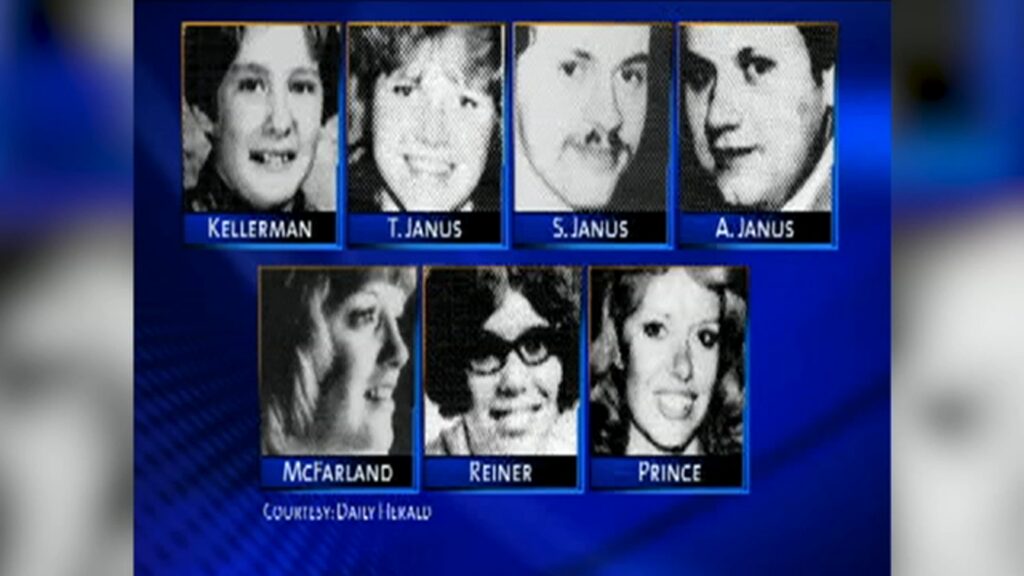The Chicago Tylenol Murders of 1982
In 1982, a shocking and tragic series of poisonings in Chicago forever altered the landscape of consumer safety in the United States. The Chicago Tylenol murders began with the unexpected deaths of seven people who had taken cyanide-laced Tylenol capsules. This tragic case highlighted vulnerabilities in consumer product packaging, led to unprecedented reforms in over-the-counter drug safety, and remains an unsolved mystery that continues to resonate decades later.
A Grim Beginning: The First Cases Emerge
On September 29, 1982, Mary Kellerman, a 12-year-old from Elk Grove Village, Illinois, complained of a sore throat. Her parents gave her a Tylenol capsule, hoping it would ease her discomfort. However, within hours, Mary had passed away, her sudden death sparking initial confusion and alarm. Not long after, other similar cases surfaced in the area.
Adam Janus, a 27-year-old postal worker from Arlington Heights, Illinois, took Tylenol for chest pains later that same day. Tragically, Adam also died shortly after taking the medication. As family members gathered to mourn his sudden loss, Adam’s brother and sister-in-law, grieving and unaware of the danger, took the same tainted Tylenol. Both succumbed to the cyanide poisoning within hours.
The link between the victims’ deaths quickly became clear: all had taken Extra-Strength Tylenol capsules purchased from various locations across the Chicago area. Within days, four more individuals had died under the same circumstances, leading to a total of seven fatalities that shook the nation.
Immediate Public Health Crisis and Law Enforcement Response
Local and federal authorities immediately sprang into action. The deaths were not only a tragedy but an urgent public health crisis, as Tylenol was one of the most widely used over-the-counter pain relievers in the country. Fearing further contamination, local officials and healthcare providers warned the public, advising them to avoid Tylenol products until further notice.
In a dramatic move, Mayor Jane Byrne and law enforcement officials ordered all Tylenol products to be pulled from store shelves in the Chicago area. With the cooperation of the drug manufacturer, Johnson & Johnson, a nationwide recall of Tylenol was swiftly initiated. This unprecedented recall sent shockwaves throughout the country, as consumers disposed of their Tylenol supplies and pharmacies stripped their shelves of the medication.
The incident raised immediate questions: How had the capsules been poisoned? Who was responsible, and what was their motive? Investigators theorized that the killer might have purchased Tylenol from local stores, injected cyanide into the capsules, and then placed them back on the shelves. With no clear suspect or motive, the case grew more complex, fueling both fear and fascination nationwide.
The Full List of Victims

Mary Kellerman
Age: 12
Location: Elk Grove Village, Illinois
Mary was the youngest victim, a cheerful 12-year-old who took Tylenol to relieve a sore throat. Her sudden death was the first in the string of poisonings, sending shockwaves through her family and igniting the initial investigation into what would become a nationwide crisis.
Adam Janus
Age: 27
Location: Arlington Heights, Illinois
A postal worker, Adam took Tylenol for what he believed to be minor chest pains. After his sudden death, his family gathered to mourn, not yet aware of the terrible danger in the bottle of Tylenol he had taken. His death, followed by the loss of his brother and sister-in-law, underscored the devastating reach of this tragedy.
Stanley Janus
Age: 25
Location: Arlington Heights, Illinois
Stanley, Adam’s younger brother, took Tylenol from the same bottle after Adam’s passing. Unknowingly ingesting the cyanide-laced capsules, Stanley succumbed to the poison shortly after, leaving his grieving family with another unimaginable loss within hours of the first.
Theresa Janus
Age: 19
Location: Arlington Heights, Illinois
Theresa, Stanley’s wife and Adam’s sister-in-law, was at the Janus family home mourning Adam’s passing when she took Tylenol from the same tainted bottle. Her sudden and tragic death deepened the grief of the Janus family, resulting in the devastating loss of three family members in a single day.
Mary McFarland
Age: 31
Location: Elmhurst, Illinois
Mary was a hardworking single mother who took Tylenol at her office in Elmhurst to alleviate pain. She became one of the seven victims, leaving behind her young children and a family devastated by the unexpected tragedy.
Paula Prince
Age: 35
Location: Chicago, Illinois
A dedicated flight attendant, Paula had just returned from a long trip when she purchased Tylenol at a Chicago drugstore. She was found dead in her apartment shortly after. The video footage of her purchasing Tylenol from a nearby Walgreens is one of the last records of her life, a haunting reminder of how close this case hit to everyday life.
Mary Reiner
Age: 27
Location: Winfield, Illinois
Mary, a young mother recovering after childbirth, took Tylenol to relieve pain at her home in Winfield. Her death not only shocked her family but also left her newborn child without a mother, underscoring the indiscriminate cruelty of the poisonings and heightening the case’s emotional impact.
Each of these victims represented a life suddenly and senselessly cut short by an act that horrified the nation. Their stories remain at the heart of the case, serving as reminders of the personal toll behind the public health crisis that ultimately transformed drug safety standards.
The Role of James W. Lewis: A Suspect Without Resolution

As law enforcement officials raced to track down leads, a man named James W. Lewis entered the spotlight. Lewis, who had a history of criminal activity, sent an extortion letter to Johnson & Johnson, demanding $1 million to stop the poisonings. This led to his arrest after a nationwide manhunt. However, despite his bold claims and detailed knowledge of the killings, Lewis ultimately denied any involvement in the actual poisonings, insisting that his extortion attempt was merely a ploy to embarrass a former employer.
Lewis’s criminal history only deepened suspicions. In the years prior, he had faced charges for mail fraud, credit card schemes, and even a dismemberment murder accusation. Despite his confession to the extortion attempt, he was ultimately not charged with the Tylenol murders due to insufficient evidence directly linking him to the poisonings.
In 2010, Lewis provided DNA samples to the FBI as part of ongoing investigative efforts, but no new information surfaced. To this day, he maintained his innocence, even creating a website to declare that he had been framed. Lewis passed away in 2023, taking with him any undisclosed knowledge he may have had about the case.
Transformative Impact on Consumer Safety and Drug Packaging
The Tylenol murders had a lasting impact on consumer safety in the United States. Before the poisonings, over-the-counter medications were sold in relatively accessible packaging, with minimal protection against tampering. The 1982 crisis revealed the devastating consequences of these packaging vulnerabilities, prompting swift changes in industry standards and regulatory policies.
One of the most significant outcomes of the Tylenol murders was the enactment of the Tylenol Bill in 1983. This law made it a federal crime to tamper with consumer products, setting a critical precedent for consumer safety. Furthermore, in 1989, the FDA established mandatory tamper-evident packaging for all over-the-counter medications. Capsules, which were easier to manipulate than other forms, were largely replaced by more tamper-resistant caplets, a change aimed at preventing similar incidents.
Johnson & Johnson’s response to the crisis also served as a model for corporate accountability. By promptly recalling all Tylenol products and cooperating fully with law enforcement, the company demonstrated a commitment to public safety that helped rebuild consumer trust over time.
Theories and Speculations
The Chicago Tylenol murders remain one of the most unsettling unsolved cases in American history, not only because of the randomness of the attacks but also due to the chilling implications of mass poisoning. Over the years, several theories and speculations have emerged, driven by the perplexing details of the case and the lack of a conclusive resolution. Here are some of the most prominent theories and speculations that have circulated around this case.
The “Random Killer” Theory
One of the leading theories is that the Tylenol killer acted as a random, lone wolf — a disturbed individual with no direct connection to the victims. According to this theory, the killer sought to cause widespread harm, fear, and chaos, with no apparent motive beyond spreading terror. Investigators suggested that the killer could have purchased Tylenol bottles from various stores in the Chicago area, injected cyanide into capsules, then returned the bottles to store shelves.
This method of poisoning was particularly devious because it leveraged the open availability of a common over-the-counter medication, making detection and prevention incredibly challenging. The randomness of the victims — with no discernible links between them aside from the use of Tylenol — lends credibility to the idea that the murders were indiscriminate and opportunistic. This theory leaves unsettling questions about whether the killer could have been anyone in the area, blending back into society unnoticed after the crime.
James W. Lewis: Prime Suspect or Opportunist?
James W. Lewis has long been the prime suspect in the case, primarily due to his attempt to extort $1 million from Johnson & Johnson, Tylenol’s parent company, after the murders. Lewis’s letter claimed responsibility for the poisonings and demanded the money to “stop the killing.” However, Lewis later stated that he had no involvement in the actual poisonings and claimed that the letter was a hoax intended to embarrass a former employer by having the money sent to their account.
Despite his denial, law enforcement was deeply suspicious of Lewis. He had a criminal history, including convictions for fraud and accusations of violent acts. Some investigators believed he had both the motive and the ingenuity to carry out the poisonings. Lewis himself provided a detailed “theory” to investigators about how the killer might have operated, which led some to believe he may have been attempting to boast about his own actions without admitting guilt directly.
In 2010, Lewis provided a DNA sample as part of a renewed investigation, but no definitive evidence linking him to the crime has been found. To this day, he denied involvement and maintained that he was being framed. When he passed away in 2023, he took with him whatever knowledge he may have had about the case, leaving his actual role, if any, in the poisonings still under intense speculation.
Corporate Sabotage Theory
Another theory that has been explored is the possibility of corporate sabotage — someone with a vendetta against Johnson & Johnson or a disgruntled former employee who sought to harm the company by targeting its flagship product, Tylenol. Supporters of this theory point to the letter from James Lewis as an example of an individual targeting Johnson & Johnson directly, though no solid evidence has connected corporate sabotage to the actual poisonings.
Johnson & Johnson’s swift recall of Tylenol and their cooperation with law enforcement are seen as clear indicators that the company had no involvement or prior knowledge of the tampering. However, some have speculated that a former employee or an outside party could have intended to damage the company’s reputation and financial standing by tampering with their product. While this theory is less popular among investigators, the idea of sabotage remains in the broader discussion of motives.
The “Copycat Killer” Fear
After the initial Tylenol poisonings in Chicago, there was widespread fear of potential “copycat” incidents. Media coverage of the case sparked nationwide anxiety about product tampering, and authorities received reports of other suspicious deaths and attempted poisonings involving over-the-counter medications. Some investigators have theorized that the Chicago Tylenol poisonings could have inspired copycat criminals who were either unsuccessful or whose attempts were thwarted early.
This fear led to enhanced safety measures, including tamper-evident seals and changes in capsule production, which were intended to make product tampering harder. While no direct evidence points to a coordinated group of copycats, isolated reports of tampering after the Tylenol case kept the theory alive and contributed to the urgency of updating packaging standards to prevent similar incidents.
An Opportunistic Killer Exploiting the Crisis
Another theory posits that the killer may have simply exploited vulnerabilities in consumer safety standards, targeting Tylenol due to its widespread use and the ease of tampering with capsule-based medications. Capsules, at the time, could be easily opened and resealed without detection. This theory suggests that the killer was not necessarily motivated by a specific vendetta but rather saw the lack of secure packaging as an opportunity to carry out a unique, high-profile crime that would shock the public.
The killer may have planned the poisonings with the understanding that there would be a lack of direct traceability, banking on the anonymity provided by random product tampering. This theory also explains the lack of definitive forensic evidence and why authorities have been unable to conclusively identify the person responsible.
FBI’s Theories and Renewed Investigations
In 2009, the FBI renewed its interest in the Tylenol murders, citing advances in forensic technology. This new investigation involved revisiting old evidence and conducting interviews with suspects, including James Lewis, who provided DNA samples at the time. While the renewed investigation did not yield a breakthrough in identifying the killer, it reignited public interest and raised questions about whether modern forensic methods might eventually solve the case.
Investigators explored several scenarios, including the idea that the killer was an anonymous individual who had no prior criminal history and may have carried out the act as an isolated event. Some in law enforcement have speculated that the individual may have passed away or left the country, which would explain the lack of subsequent similar attacks and the limited trail of evidence.
A Legacy of Speculation and Fear
The Chicago Tylenol murders remain unsolved, and speculation about the identity and motives of the killer continues to haunt both investigators and the public. The fact that the case remains open and active means that new theories and perspectives will likely continue to emerge. As one of the most unsettling unsolved crimes in modern American history, it has become a cultural touchpoint for discussions about trust, safety, and the unpredictable risks of everyday life.
To this day, the Chicago Tylenol murders stand as a reminder of how fragile safety can be, as well as a cautionary tale about the vulnerabilities in our consumer system. Whether the case is eventually solved or remains a haunting mystery, the theories surrounding it contribute to its legacy as a chilling, unresolved chapter in American history.
Lingering Questions and the Case’s Unresolved Status
Despite the enormous investigative efforts that followed, the Tylenol murders remain unsolved. Advances in forensic technology and renewed efforts by the FBI and Illinois State Police have yet to yield any conclusive evidence that would identify the person responsible. The mystery surrounding the case has made it a compelling subject of speculation and intrigue, and it continues to haunt the families of the victims, who have struggled for decades to find closure.
Many who were close to the case have spoken out over the years, expressing frustration with the lack of accountability and the case’s impact on their lives. Helen Jensen, a retired nurse who helped treat the first Tylenol victims, has publicly voiced her belief that Lewis was indeed responsible, though the case against him was never substantiated. Jensen’s early suspicion that the Tylenol capsules had been tampered with was initially dismissed by investigators, underscoring the challenges women faced in being taken seriously by law enforcement at the time.
The long-standing uncertainty has left families like the Janus family, who lost three loved ones, with unanswered questions. In interviews, some family members have described the investigation as sloppy and inadequate, believing that critical opportunities to identify the killer may have been missed.
Lasting Legacy and Cultural Impact of the Tylenol Murders
The Tylenol murders not only led to policy and packaging changes but also transformed the American public’s relationship with consumer products. Before 1982, few people questioned the safety of products bought at a pharmacy or grocery store. The murders shattered this trust, creating a culture of caution and vigilance regarding product tampering and safety.
The incident has also permeated American popular culture, serving as a reference point in discussions of crime and public safety. It has inspired countless news articles, documentaries, and even fictional works exploring the chilling implications of an unsolved mass poisoning. The Tylenol murders are often cited as a turning point in corporate responsibility and consumer protection, a tragic reminder of the importance of safety standards.
The case stands as one of America’s enduring mysteries. While many of the individuals closest to the case have passed away or are now in old age, their memories and calls for justice continue to resonate. The story of the Tylenol murders is a sobering chapter in Chicago’s history and a powerful illustration of how a single, heinous act can reshape society’s values and priorities.
Discover more from City Towner
Subscribe to get the latest posts sent to your email.




